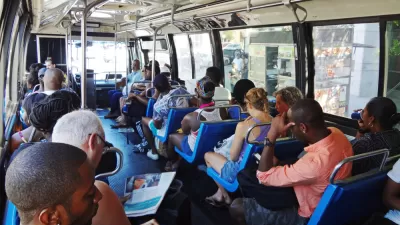While autonomous vehicles still face regulatory and technical challenges, investment in basic transportation infrastructure like buses and bike lanes can go a long way toward improving safety and taking cars off the road.

Despite rosy predictions that autonomous vehicles would rule American roads by now, writes Jacob Silverman in The New Republic, the technology still faces plenty of challenges, signaled in part by major ride-sharing companies shedding their autonomous vehicle divisions. "Across the industry, autonomous vehicle efforts have proven to be stubbornly difficult to bring to fruition, consuming billions of R&D dollars and thousands of engineering hours. Meanwhile, the infrastructure needed to support autonomous cars—government investment in roads, highways, communications, along with proper regulatory oversight—remains inadequate to the challenge." But in order to increase safety on roads, "[w]hat we need are not more energy-efficient cars or self-driving cars … but fewer cars entirely," argues SIlverman.
"In contrast to all the hype and expense of autonomous vehicles—along with the regulatory and technical and economic uncertainty—bicycles, sidewalks, and public transport work exceedingly well. They are known quantities that can be strengthened and made more accessible with a fraction of the resources that have been poured into A.V. research. They are safe and enhance the urban experience. They contribute few, if any, emissions and don’t enrich a handful of oligarchs at the expense of the common interest."
Instead of investing in "very expensive and glitzy pilot projects" that work, at most, as tourist attractions, Silverman proposes that "a better way of saving lives is to have fewer cars on the road, replaced by mass transit and other public options."
FULL STORY: Forget Tech Bro Fantasies of Self-Driving Cars and Just Invest in Buses Already

Alabama: Trump Terminates Settlements for Black Communities Harmed By Raw Sewage
Trump deemed the landmark civil rights agreement “illegal DEI and environmental justice policy.”

Planetizen Federal Action Tracker
A weekly monitor of how Trump’s orders and actions are impacting planners and planning in America.

The 120 Year Old Tiny Home Villages That Sheltered San Francisco’s Earthquake Refugees
More than a century ago, San Francisco mobilized to house thousands of residents displaced by the 1906 earthquake. Could their strategy offer a model for the present?

In Both Crashes and Crime, Public Transportation is Far Safer than Driving
Contrary to popular assumptions, public transportation has far lower crash and crime rates than automobile travel. For safer communities, improve and encourage transit travel.

Report: Zoning Reforms Should Complement Nashville’s Ambitious Transit Plan
Without reform, restrictive zoning codes will limit the impact of the city’s planned transit expansion and could exclude some of the residents who depend on transit the most.

Judge Orders Release of Frozen IRA, IIJA Funding
The decision is a victory for environmental groups who charged that freezing funds for critical infrastructure and disaster response programs caused “real and irreparable harm” to communities.
Urban Design for Planners 1: Software Tools
This six-course series explores essential urban design concepts using open source software and equips planners with the tools they need to participate fully in the urban design process.
Planning for Universal Design
Learn the tools for implementing Universal Design in planning regulations.
Clanton & Associates, Inc.
Jessamine County Fiscal Court
Institute for Housing and Urban Development Studies (IHS)
City of Grandview
Harvard GSD Executive Education
Toledo-Lucas County Plan Commissions
Salt Lake City
NYU Wagner Graduate School of Public Service





























